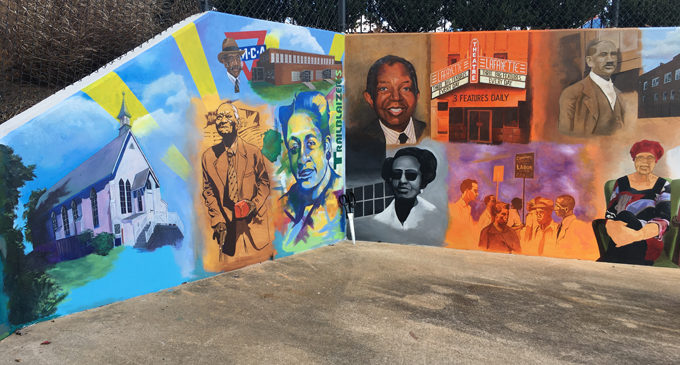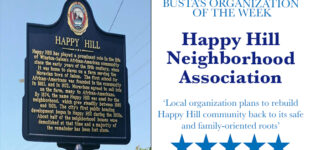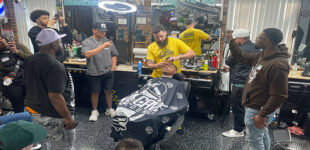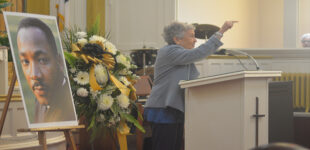The walk of discovery: meeting the artist of the Depot Street Renaissance Mural
The mural of Depot Street was painted by Winston-Salem native Leo Rucker.

By Dr. Karen F. Williams
I have always heard that walking is good for your health. The sound of soles pulsating paved trails, timber bridges, gravel walkways, concrete sidewalks, or plain dirt paths, reaps a harvest of health benefits. But my experience has been that walking is more than physical exercise.
In February 2019 a former colleague, Constance Archie, and I began walking in the Winston-Salem area. Later we met Carlos Sawyer and he joined us. After walking for several months, our faith bonded the three of us as friends. What began as a means to boost healthy living soon moved toward steps on a journey, a spiritual walking journey. As we walked it became clear that life is not happenstance as we met persons who inspired.
Meeting visual artist Leo Rucker is an example. When we met Leo, he had scarcely begun work on a mural, situated on East 7th Street between Patterson Avenue and Research Parkway. His artwork, “The Depot Street Renaissance Mural,” depicts the Depot Street neighborhood, a Winston-Salem African American community during the late 18th and early 19th centuries.
“My goal was to create a story that would be inviting, colorful, and create conversation for the entire community,” Leo told us.
Constance commented, “Prior to meeting the artist, the beginning stages of the mural captured my attention, particularly because it is located along our walking trail, hence inclusive of our spiritual walking journey.” She continued “It is a mural, even in its early stage, that was vibrant and interesting because its images are of African Americans in their community. During our consistent walking, I saw the mural develop into a story that depicts the life of African American business owners and professionals in Winston-Salem during a time when segregation was prominent.”
The story Leo’s Depot Street art chronicles is an eye-catching creation. It is no coincidence that the first image on the mural is a church, Lloyd Presbyterian Church, the second oldest African American church in Forsyth County. Leo explains, “Growing up, church was the core of my family. As I grew up, I developed my own personal relationship with God as I began to understand that a higher being was guiding my footsteps creatively. I started with the Lloyd Presbyterian Church on the mural as the foundation of faith and for years the church would be for many communities.”
As I reflect on this impressive public art, I see how art, as well as walking, connects people to creation, history, and hope.
Connecting to Creation
Like the aesthetics of Leo’s handiwork, nature demonstrates God’s ubiquitous artistry. On our walks, Constance, with her horticultural gifting, assisted Carlos and me with observing the plants, flowers, and vegetable gardens, as well as identifying their seasons of planting and harvesting.
“To fully appreciate and enjoy life, one must slow down, open one’s heart and mind to see and hear God in His manifested beauty,” asserts Constance.
Walking then can elicit an appreciation and love for God’s beautiful world. Carlos states it succinctly: “Love the environment as God loves it. Love the beauty of God’s work.”
Along with creation, The Depot Street mural is a bridge to history, African American history.
Connecting to History
The Lincoln Theatre. Safe Bus Company. LaMae Beauty College. Clark S. Brown. George Black. These are a few images illustrated on the mural. As a native of Winston-Salem, Carlos is conversant with the city’s history, specifically the Depot Street legacy. He not only remembers Depot Street, which is now Patterson Avenue, but also was a part of the community.
“As I approached Leo, I felt ecstatic about his artwork,” Carlos reveals. “We began talking about the mural and how I was able to identify the pioneers (African Americans) and the buildings designed and owned by various African Americans. The individuals displayed on the mural were innovators who gave of their talents, knowledge, and contributions to the African American citizens of Winston-Salem, as well as the United States of America.”
The YMCA, according to Carlos, was a staple for the community and a multifunctional facility. “I remember attending the after-school programs. The Y was used for numerous functions, for example, the church’s banquet.”
History is the major theme of the mural’s message and reveals a “history that all must be reminded of how African Americans contribute to this country,” said Constance. “The talents and gifts we bring to the table the world did not give; therefore, the world cannot take them away! It is a history that must not be forgotten but shared with other generations of African Americans (young and old).”
As the mural brings African American history to the forefront, walking concurrently can conjure your own personal history, inviting an answer to the questions: Who am I? Who might I become?
Connecting to Hope
The Depot Street mural not only links us to history, but also joins us to unity and hope. It shows the “strength of African Americans when we commune in unity as in the word COMMUNITY,” notes Constance.
“I hope viewers will take away the beauty of the community as this represents a generation before my time, a fun and exciting place to come and visit, learn, and be enlisted,” Leo confirms.
Likening the mural to the Black Wall Street in Winston-Salem, Carlos envisions the message of hope it conveys for African Americans. “It gives us hope that we can have and achieve ownership if we as a people are willing to make the necessary sacrifices to achieve our goals. We can reach back and be of service to others by leaving lasting legacies behind, creating a “blueprint.”
Just as the mural can serve as a catalyst of hope, so does walking. Walking can provide a sense of purpose and produce hope. Carlos, Constance, and I have received renewed hope as we walked and experienced God as He provides clarity of purpose and direction for our lives.
If you have not seen “The Depot Street Renaissance Mural” take a moment, take a walk to see Leo’s impressive creation, to reflect on African American history and renew your hope for the future.
You can discover more about Leo Rucker’s mural at www.innovationquarter.com/depot-street/
Constance Archie and Carlos Sauyer contributed to this story.















